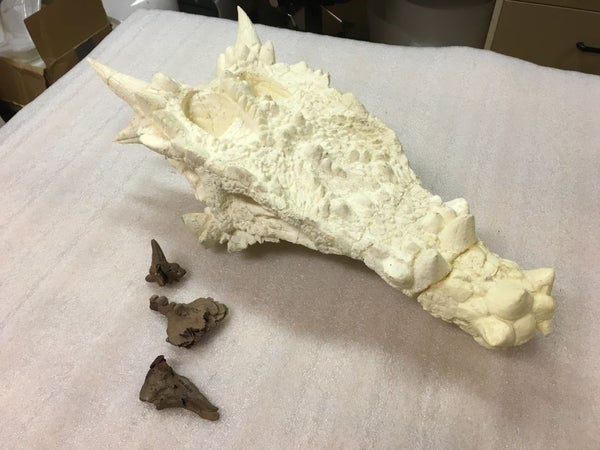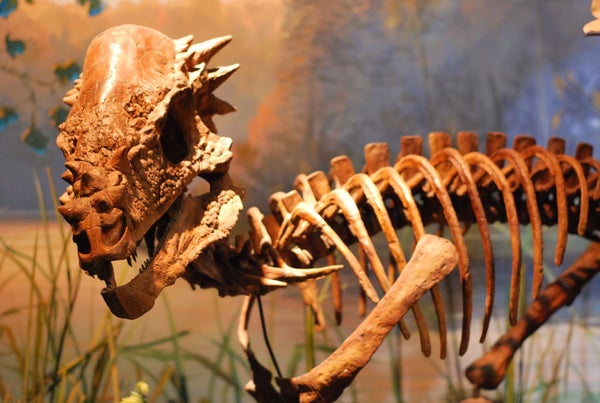This article was published in Scientific American’s former blog network and reflects the views of the author, not necessarily those of Scientific American
The three bones were some of the smallest pieces of dinosaur I had ever seen. Royal Ontario Museum paleontologist David Evans brought the rugose, chocolate colored pieces in a box smaller than my hand, set down next to a cast of a young dinosaur’s skull that looked absolutely enormous by comparison. Despite the difference in scale, though, the facsimile cranium and the authentic fossils shared a great deal in common and revealed the identity of the animal Evans had brought out to show me. What I was looking at was the smallest Pachycephalosaurus ever found.
Pachycephalosaurus stands out in the dinosaur pantheon as the largest, last, and - thanks to The Land Before Time and Jurassic Park: The Lost World - most famous of the “bonehead” dinosaurs. They roamed western North America in the same haunts as Tyrannosaurus and Triceratops between 68 and 66 million years ago, their thick, rounded skull domes highlighted by a tonsure of little spikes surrounding the outer edge. And, as is the case with most dinosaurs, the name of the species conjures up images of the adult animals in the prime of life. Yet we know that Pachycephalosaurus started out life as tiny hatchlings. The small skull bones Evans and Mark Goodwin described last year get us closer than every before to the early days of this thick-skulled dinosaur.

The bones of the young Pachycephalosaurus next to a cast of “Dracorex” in the ROM collections. Credit: Brian Switek
On supporting science journalism
If you're enjoying this article, consider supporting our award-winning journalism by subscribing. By purchasing a subscription you are helping to ensure the future of impactful stories about the discoveries and ideas shaping our world today.
The three bones—part of the cheek, the midline bone at the back of the skull, and a bone with small spikes jutting from it—were found in two Hell Creek Formation bonebeds in Garfield County, Montana. It’s literally a handful of material, but the combination of bumps and knobs and spikes on the three bones allowed Evans and Goodwin to confirm that the pieces really did belong to a very young Pachycephalosaurus. In fact, the three help tie together a hypothesis that has turned three different dinosaurs into one.
Up until about 2009, paleontologists identified three different pachycephalosaurs from the Hell Creek Formation. There was a small, flat-headed form called Dracorex, a dome-headed mid-size species with large spikes called Stygimoloch, and the classic, large Pachycephalosaurus. But in that year Goodwin and Jack Horner proposed that Dracorex and Stygimoloch were really just immature Pachycephalosaurus, the differences in their skulls being signs of growth rather than different species.
Here’s where the baby skull comes in. The stubby points on the bone from the back of the skull, the squamosal, are clustered in the same way as “Dracorex,” “Stygimoloch,” and some adult-stage Pachycephalosaurus skulls. These spikes became set very early in life. Likewise, the flat bone from the skull roof shows ornamentation similar to that of “Dracorex” as well as the beginnings of a “void space” inside from the beginnings of dome growth. So even though some aspects of skull ornamentation changed throughout the growth of Pachycephalosaurus, the anatomical groundwork was already set in place when these dinosaurs were little scrappers.
So Pachycephalosaurus were fairly spiky early on. They didn’t start to grow ornaments with the onset of sexual maturity, but already had knobbly skulls in the early years of their lives. And while distinctive, these points and bumps wouldn’t have offered any defense against predators lurking in those Cretaceous woodlands. Instead, Evans and Goodwin point out, the spikes and domes in different arrangements might have been signals of age class, allowing Pachycephalosaurus to pick out who’s who in a crowd. In other words, these dinosaurs were showoffs from the time they were born.
Reference:
Goodwin, M., Evans, D. 2016. The early expression of squamosal horns and parietal ornamentation confirmed by new end-stage juvenile Pachycephalosaurus fossils from the Upper Cretaceous Hell Creek Formation, Montana. Journal of Vertebrate Paleontology. doi: 10.1080/02724634.2016.1078343
[This post was originally published at National Geographic.]
